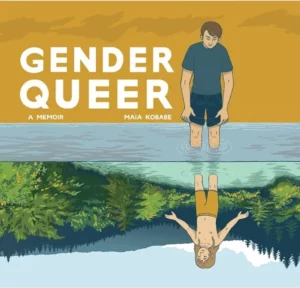We have been following public attempts to ban books which discuss sexuality and/or gender identity, including books about the Holocaust (see Maus), in the United States over the past year. Before, efforts were focused on children, pre-K to elementary school; however now, politicians in the state of Virginia want to ban certain books from being sold in the state to minors without parental consent.
In May, two Virginia Republicans approached a retired state judge (since all other judges recused themselves) to ask her to find “probable cause” that two books were “obscene,” which allowed the politicians to next file a petition under another state law (unused since the 1970s) to demand that Barnes & Noble, a private actor, stop selling Gender Queer by Maia Kobabe, a memoir about gender identity, and A Court of Mist and Fury, by Sarah J. Maas, a novel, to minors without parental consent. The order would also prohibit distribution of the books by Virginia Beach City Public Schools. When the Republican Party has spent so much time dismantling big government from local affairs, they seem to want very much to regulate the books market. Even the Holy Bible was pulled from shelves for a review along with other books this past week in Texas.
Politics aside, let’s look at the law. Whatever your personal, subjective opinion is about gender identity, sexual orientation, or the Holocaust, among other hot topics, it matters not because all views are welcome in the United States. That is because our country holds a pluralist society. That means, there are more than one religion, ethnicity, race, gender, and much more that characterizes the human beings that make up the citizenship of our nation. When our founders were drafting the Constitution, the Federalist Papers began a press junket of sorts to promote the idea of a strong, central government, as a good thing for the states. Because the states were wary over a central power (they had just gotten rid of King George III, thanks), they insisted on the Bill of Rights as their insurance policy. The First Amendment of the Bill of Rights is the most well known because it guarantees the freedom of speech, press, assembly, religion, and to petition government for grievances. It was not until 100 years later, that the Supreme Court began incorporating these same Bill of Rights into individual liberties via the 14th Amendment’s Due Process clause.
The freedoms therefore granted us as individual citizens under the First Amendment, are balanced somewhat by obscenity law. In the U.S., the earliest statute known is the Obscene Publications Act of 1857. In 1868, the Supreme Court ruled in Regina v. Hicklin, creating the Hicklin Rule, which allowed magistrates to order seizure and condemnation of books to be kept, sold, or distributed if such would be indicted under law. The test of obscenity was thus two fold – the nature of the work (i.e., to deprave and corrupt) and the hands into which it falls (i.e., children). The rule was particularly effective when directed at children. A few years later in 1873, Congress passed the Comstock Act, which made it unlawful to send “obscene, lewd, lascivious, immoral, or indecent” publications by postal mail and a misdemeanor to sell, lend, or own an obscene book.
Fast forward 84 years, and in 1957, the Supreme Court of the United States decides Roth v. United States and restates the Hicklin Rule, that “obscene” material is whether to the average person applying contemporary community standards, the dominant theme of the material taken as a whole appeals to the prurient interest. Notably, sex was protected albeit obscenity was not. The restated rule appeared again in Memoirs v. MA (1966), effectively narrowing the concept of what is obscene. In 1973, in Miller v. California, the Supreme Court decided to change the standard of review for obscenity to whether material has any serious literary, artistic, political, or scientific value and added whether work depicts or describes in a patently offensive way sexual conduct specifically defined by state law (which back then, was different from today). But perhaps the biggest question was what exactly defines “community standards,” since in a pluralist society, those can vary greatly from locality to locality.
In Miller, that community was to be the state in which the action rises. Circling back, then the community standard applied in the Virginia book ban case, would be the state of Virginia. In 1990, the obscenity test was put to task again, this time thanks to artist Robert Mapplethorpe in Cincinnati v. Contemporary Arts Center, which restated the test as whether, the average person applying contemporary community standards would find that the work, taken as a whole, appeals to the prurient interest; whether the work depicts or describes, in a patently offensive way, sexual conduct specifically defined by applicable state law; and, whether the work, taken as a whole, lacks serious literary, artistic, political or scientific value. But what does prurient interest even mean?
Pandering and prurient interest is defined as a lewd, leering, perverted interest in sex, not simply to a person’s normal, natural, healthy interest in sex and sexuality. But how does a person distinguish the two? Easy. Prurient typically repulses an average person with an interest in sex and does not arouse them where it would a person with a perverted understanding of sex. An example of this might be gratuitous exhibitionism, voyeurism, or harming animals, all of which are codified as criminal acts (i.e. indecent exposure, stalking, animal cruelty) under state laws. This makes the obscenity test quite straightforward when viewing material in line with what is codified under “applicable laws.” And perhaps the most grievous crime is child pornography, which is what the Virginia politicians seeking this injunction accuse Gender Queer of promoting, when opponents argue the young author is exploring their gender and sexuality. I find it highly unlikely that a person seeking to access real child pornography, that is, materials where children are in fact used in sexual depictions and acts, would make a bee-line for Gender Queer as a mainstay to uphold the black market.
Whatever your opinion may be, the hearing to consider the lawsuits is set for August 30, to determine whether the books are in fact, obscene. Numerous briefs have been submitted, including this one from Fire and the Woodhull Freedom Foundation, which explores how the obscenity test has historically been wielded against LGBTQIA+ people, organizations, and materials. Given that the case arose in Virginia, we might guess that the community standard of the state of Virginia will apply. But how does one even define that? Perhaps, there will be expert testimony, or comparable materials available in the area (maybe even sold by Barnes & Noble, one of the defendants), or statistical evidence. In any case, we will follow the outcome of this case with interest.




